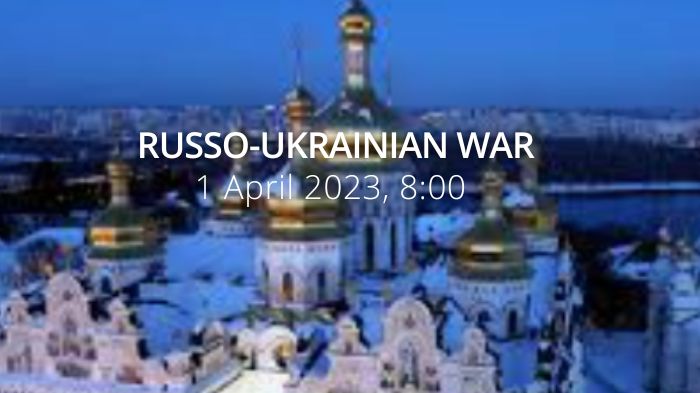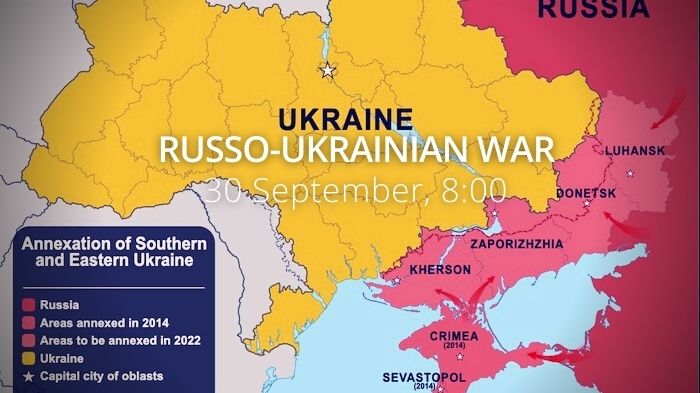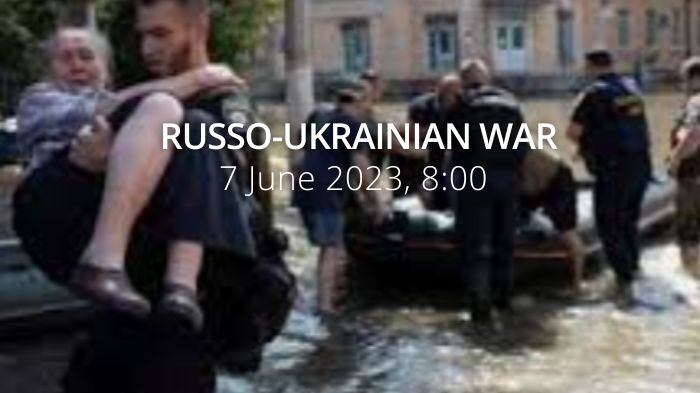Fierce fighting in Donbas. The Ukrainian flag raised above 12 settlements in the Luhansk Oblast. Ukraine and its allies work to develop a Joint Declaration on Air Shield.
Daily overview — Summary report, November 20
A map of the approximate situation on the ground in Ukraine as of 00:00 UTC 20/11/22. pic.twitter.com/fK1W0eO57y
— War Mapper (@War_Mapper) November 20, 2022
https://twitter.com/EuromaidanPress/status/1593989532491259904
The General Staff’s operational update regarding the Russian invasion as of 06.00 am, November 20, 2022 is in the dropdown menu below:
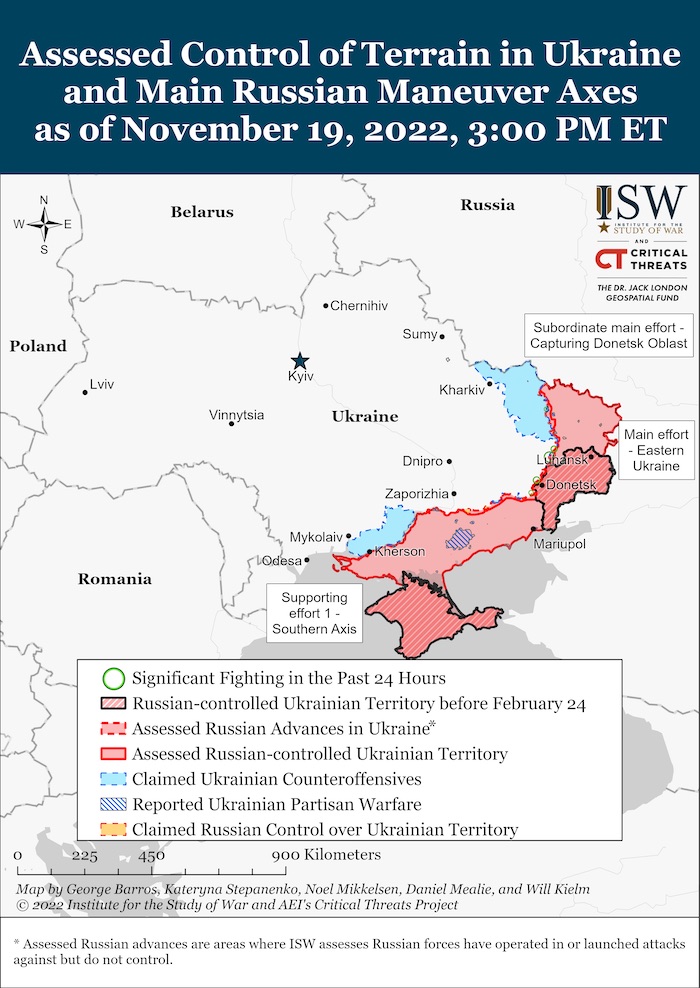
“Russian forces continue armed aggression against our state and do not stop striking industrial facilities. Focuses efforts on restraining the actions of the Defence Forces, and carries out equipment in the engineering aspect of the defence line. It continues to conduct offensive actions in certain directions.
Over the past day, units of the Defence Forces have repelled attacks by Russian occupiers in the areas of the settlements of Bilohorivka in the Luhansk oblast and Spirne, Yakovlivka, Bakhmutske, Bakhmut, Opytne and Klishchiivka in the Donetsk oblast.
Russian forces made 1 airstrike and 4 missile strikes and launched 59 MLRS attacks.
In violation of the norms of International Humanitarian Law, the laws and customs of warfare, the objects of the civil infrastructure of the cities of Sviatohirsk and Kramatorsk were subjected to missile strikes by the Russian Federation.
In the Volyn, Polissya, and Siverskyi directions, the situation has not changed significantly, and no signs of the formation of offensive groups have been detected. Russia maintains its units in the border areas of the Bryansk and Kursk regions. It is not excluded that Russian forces will attempt armed provocations on the state border, as well as attempts to penetrate enemy sabotage and reconnaissance groups from the territory of the Russian Federation and the Republic of Belarus.
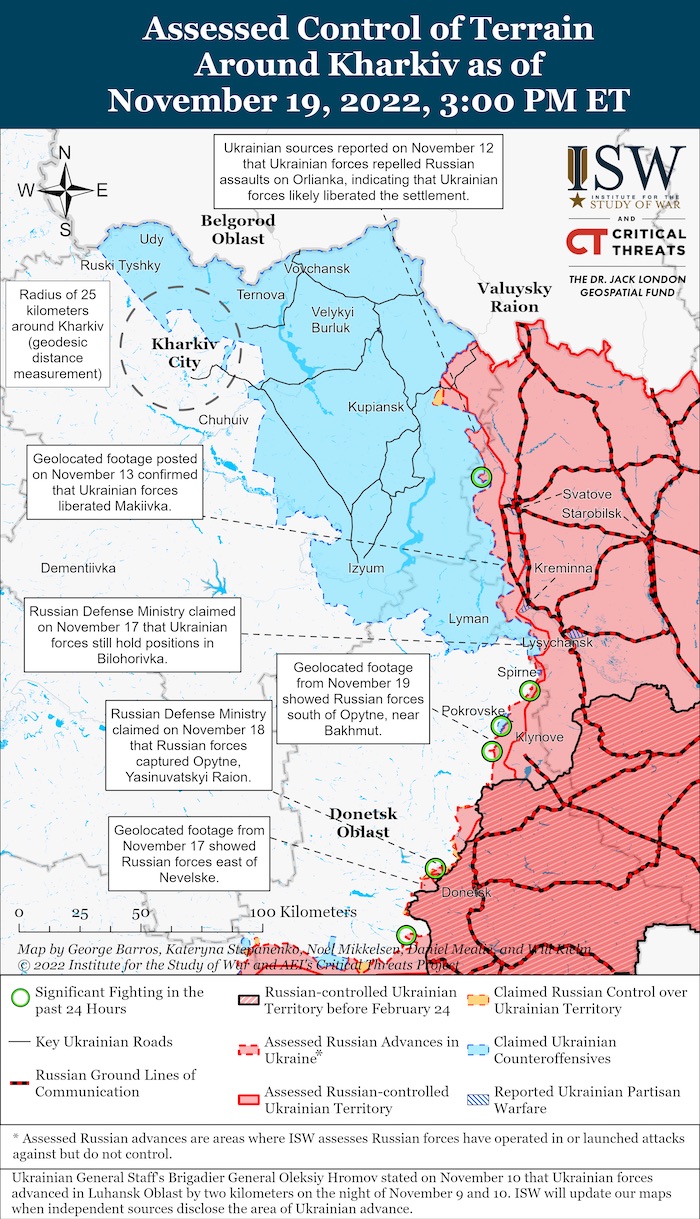
- In the Slobozhansky direction, in the border areas of the Belgorod region, Russian forces continue to cover the Russian-Ukrainian border with designated units and conduct demonstrations and provocative actions. It carried out mortar shelling in the area of the Starytsa settlement of Kharkiv oblast.
- In the Kupiansk and Lyman directions, the occupiers are conducting defence on the captured lines. Enemy shelling from mortars, artillery and MLRS was recorded, in particular, in the areas of Krokhmalne and Tabaivka settlements of Kharkiv oblast; Novoselivske, Stelmakhivka, Makiivka, Ploshanka and Nevske in the Luhansk oblast and Berestove in the Donetsk oblast.
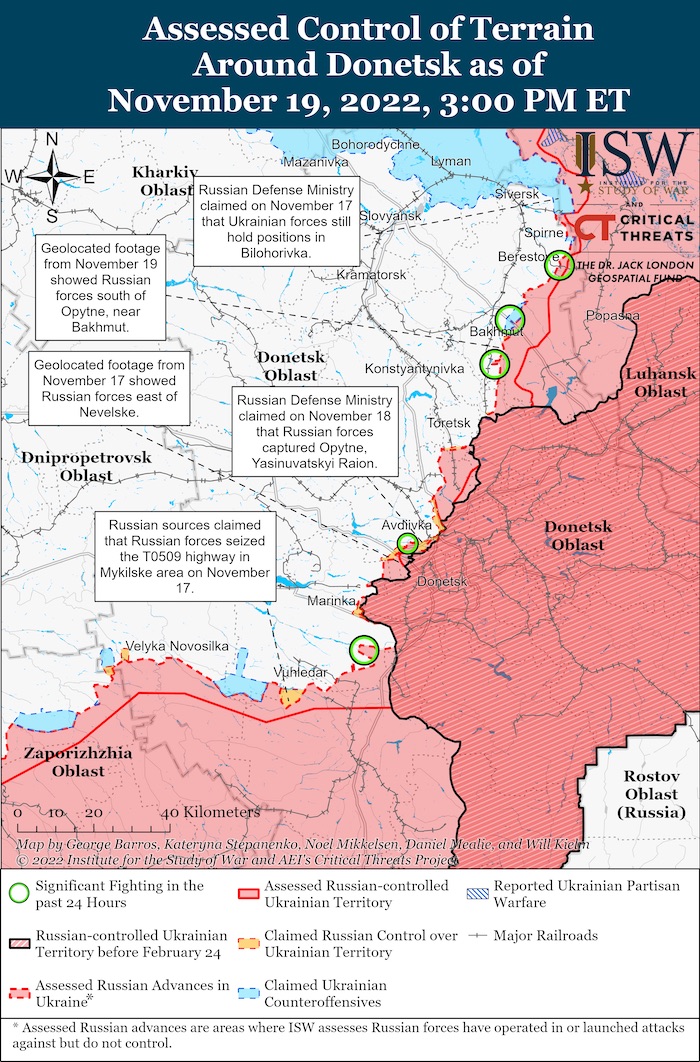
- In the Bakhmut, Avdiivka, and Novopavlivka directions, Russian forces are concentrating their main efforts on conducting offensive operations. Conducts shelling from tanks and the entire range of artillery in the areas of settlements of Verkhnokamianske, Spirne, Bilohorivka, Rozdolivka, Vesele, Yakovlivka, Soledar, Bakhmutske, Bakhmut, Opytne, Klishchiivka, Andriivka, Kurdyumivka, Ozaryanivka, Krasnohorivka, Pervomaiske, Mariinka, Novomykhailivka, Vuhledar and Vremivka of the Donetsk oblast.
- In the Zaporizhzhia direction, the occupiers are defending themselves on captured borders. Areas of the settlements of Novopil, Nove, Chervone, Hulyaipole, Dorozhnyanka, Zaliznychne, Mala Tokmachka, Orihiv, Plavni, Stepnohirsk and Vyshchetarasivka of the Zaporizhzhia oblast were affected by artillery fire.
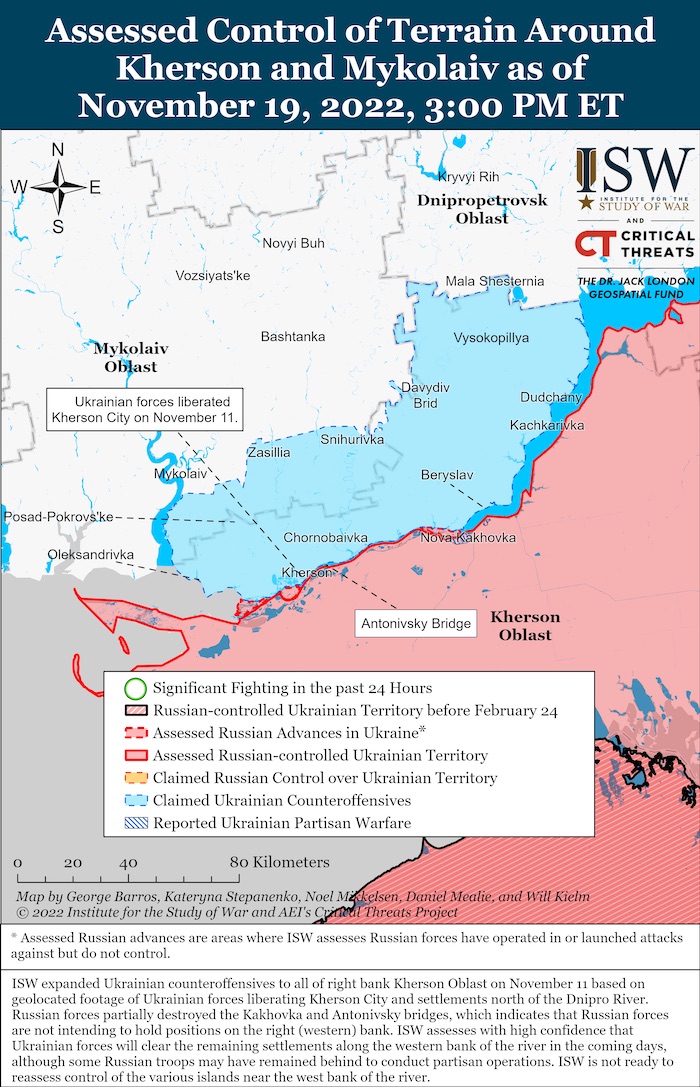
- In the Kryvyi Rih and Kherson directions, Russian forces are conducting positional defence, improving fortification equipment and logistical support of advanced units, and do not stop artillery shelling of the positions of our troops and settlements on the Right bank of the Dnipro River. In order to clarify the positions of our troops and adjust the artillery fire, the UAV conducts aerial reconnaissance. Directed fire from tanks, artillery and MLRS in the districts of Kachkarivka, Tokarivka, Antonivka, Chornobayivka and the city of Kherson.
According to available information, the command of the Russian occupying forces plans to redeploy separate units withdrawn during the retreat from the right bank of the Dnipro River in the Kherson oblast to continue hostilities in the Donetsk and Luhansk oblasts. The mobilized persons, most of whom make up these formations, are very indignant at the prospects of the implementation of the mentioned plans.
In the Luhansk oblast, the Russian occupiers are setting up additional checkpoints to identify and detain deserters.
[According to available information, the military training of units of the 2nd Motorized Rifle Division of the 1st Tank Army of the Armed Forces of the Russian Federation, which took place in the territory of the Brest region of the Republic of Belarus, has ended. Military personnel called up in the course of the so-called partial mobilization have a low level of morale and psychological state, in particular, due to unsatisfactory provision. Part of the specified staff received old uniforms and equipment that had already been used. Military equipment, for the most part, is in poor technical condition - constantly in need of repair.]
[Russian forces continue to suffer losses. On November 17, in the settlement of Mykhailivka in the temporarily occupied territory of the Zaporizhzhia region, fire damage was confirmed at the place of concentration of the occupiers. It is known that the losses of Russian forces amounted to more than 30 wounded and dead.]
[According to detailed information, as a result of the fire attack by Defence Forces against areas of concentration of Russian forces' near Mykhailivka, Skadovsk district, Kherson oblast, on November 17, the invaders' losses amounted to about 60 people killed.]
[An increase in the number of occupation units of Russian troops is noted in the city of Luhansk. In the settlements of Krasne and Simeykyne in the temporarily occupied territory of the Luhansk oblast, Russian forces place personnel in abandoned residences and forcibly evicts the civilian population from their homes to other settlements.]
On November 18, in the settlements of Vasylivka, Novobohdanivka, Mykhailivka (Vasylivsky District) and Komysh-Zorya in the temporarily occupied territory of the Zaporizhzhia oblast, the results of fire damage by units of the Defense Forces were confirmed. The occupiers suffered more than 160 wounded. About 10 units of military equipment of various types and a warehouse of ammunition were destroyed. Information about the dead is being clarified.
Over the past day, our soldiers shot down an Orlan-10 UAV and hit a Russian control post and ammunition depot.“
Military Updates
Ukraine's general’s command style “allows others to realise their capacities and talents”, whereas in Russia’s military, “only one to two people make decisions and the rest are told to shut up.” “No way the Ukrainians pause for the winter . . ." https://t.co/nBj0qmCl4x
— Euromaidan Press (@EuromaidanPress) November 20, 2022
Ukrainian flag raised above 12 settlements in Luhansk region, Ukrinform reports, quoting Serhii Cherevatyi, the spokesperson for the Eastern Grouping of the Ukrainian Armed Forces. “Having large forces on the eastern front, in the Donbas, Russians had been unable to break the defence even near Bakhmut and Avdiivka for over four months. Of course, this requires us to concentrate our efforts. Moreover, the enemy is already losing in the Luhansk region. Twelve settlements are now under the Ukrainian flag. In many ways, the initiative is ours there, Cherevatyi told.
After the enemy’s strategic plans failed, they were unable to seize Kyiv and suffered defeats in the Kharkiv, Lyman and Kherson directions, all that remains is to achieve some tactical victories. Since during the war and even before one of the Russian propagandist narratives was the ‘liberation of the people of Donbas’, who had been unknown to anyone before, it is clear that they want to reach the administrative borders of the Luhansk and Donetsk regions. Hence, if they reached these borders, they would want to capture the entire Zaporizhzhia region, Cherevatyi noted.”
Massive Russian missile attacks confirm need to recognize Russia as state sponsor of terrorism – Dep Head of Ukraine President's Office to European Parliament delegationhttps://t.co/NqZ3nzfFMC
— Euromaidan Press (@EuromaidanPress) November 20, 2022
Fierce battles raging in Donbas, but it is too early to speak of broad front offensive – Ihnat, Ukrinform reports. “Through massive missile attacks, Russians want to make Ukraine negotiate on their terms, but there is no broad front offensive at the moment. The relevant statement was made by the Spokesperson for the Air Force of the Armed Forces of Ukraine, Yurii Ihnat. The first reason is that they want to defeat us. It is clear they want to impose certain conditions, they want to make us negotiate, Ihnat told.
Meanwhile, massive missile attacks do not indicate a new broad front offensive at the moment, Ihnat added. Offensive actions are now taking place in the Bakhmut direction and the Avdiivka direction only. It is, probably, too early to speak of a noticeable offensive. But, we can see that fierce hostilities are taking place in the Donbas. The [front] line has somewhat stabilized. Now the contact line is the Dnieper. […] The enemy is conducting offensive actions in the Bakhmut and Avdiivka directions. Can it be a broader offensive? Time will tell, Ihnat explained.
In his words, Russians are using reserves they had had on the southern front. The enemy is redeploying them to the eastern direction, as well as some weapons from Belarus.”
Russia is trying to overwhelm Ukrainian air defence supplies, US official warns - SkyNews
Colin Kahl says that Russia is aiming to dominate the Ukrainian skies by forcing Ukraine to use its much-needed supplies.https://t.co/HSOOiEhWoz
— Euromaidan Press (@EuromaidanPress) November 19, 2022
Russia’s FSB sets up special groups to track down members of the Ukrainian resistance, Ukrainska Pravda reports, citing the National Resistance Center. "Despite the intensification of repressions, the Russians cannot establish full control over the temporarily occupied territories.
Therefore, the Russian secret services have started hunting down partisans. For this purpose, so-called temporary operational groups have been set up in the temporarily occupied territories (TOTs) to track them down. The groups include officers from the FSB counterintelligence department and other representatives of various Russian services."
According to British Defence Intelligence, (last 48 hours):
- Russia’s recent withdrawal from west of Kherson was conducted in relatively good order compared to previous major Russian retreats during the war.
- During the retreat, vehicle losses were likely in the tens rather than hundreds, while much kit that was left behind was successfully destroyed by Russian forces to deny it to Ukraine.
- This relative success is likely partially due to a more effective, single operational command under General Sergei Surovikin. However, the force remains riven by poor junior and mid-level leadership and cover-up culture. For example, in recent months two companies subordinate to the Eastern Military District fled after their commander was killed. Other officers likely lied in an attempt to cover up the incident.
- On 16 November 2022, Russia conducted its largest ever debt issuance in a single day, raising RUB 820 (USD $13.6 billion). This is important for Russia as debt issuance is a key mechanism to sustain defence spending, which has increased significantly since the invasion of Ukraine.
- Russia’s declared ‘national defence’ spending for 2023 is planned at approximately RUB 5 trillion (USD $84 billion), a more than 40% increase on the preliminary 2023 budget announced in 2021.
- Debt issuance is expensive during periods of uncertainty. The size of this auction highly likely indicates the Russian Ministry of Finance perceives current conditions as relatively favourable but is anticipating an increasingly uncertain fiscal environment over the next year.
Losses of the Russian army
As of Sunday 20 November, the approximate losses of weapons and military equipment of the Russian Armed Forces from the beginning of the invasion to the present day:
- Personnel – about 84210 (+330),
- Tanks – 2886 (+1),
- Armoured combat vehicles – 5817 (+2),
- Artillery systems – 1868 (+1),
- Multiple rocket launchers –MLRS - 393 (+0),
- Air defence means – 209 (+0),
- Aircraft - 278 (+0),
- Helicopters - 261 (+0),
- Automotive technology and fuel tanks – 4371 (+3),
- Vessels/boats - 16 (+0),
- UAV operational and tactical level – 1537 (+1),
- Special equipment – 161 (+0),
- Mobile SRBM system – 4 (+0),
- Cruise missiles – 480 (+0)
About 500 wounded Russian soldiers were brought to Horlivka hospitals, Ukrinform reports. “From November 10 to 16, about 500 wounded Russian soldiers, most of whom were recently mobilized, were brought to Horlivka hospitals from the Mayorsk direction.”
Iran to help Russia build drones for Ukraine war, Reuters
reports. “Russia has reached an agreement with Iran to begin manufacturing hundreds of unmanned weaponised aircraft on Russian soil, The Washington Post reported, citing intelligence seen by the US and other Western security agencies.
The Post said Russian and Iranian officials finalized the deal during a meeting in Iran in early November. Russia and Iran are moving rapidly to transfer designs and key components that could allow production to begin within months, three officials familiar with the matter said, according to the newspaper.”
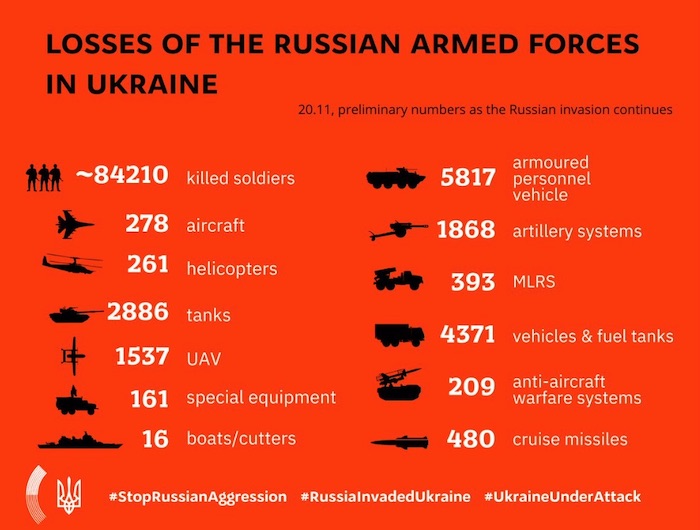
Humanitarian
https://twitter.com/MFA_Ukraine/status/1594261398955380737
Almost 50% of Ukraine's energy system was disabled by missile attacks, Ukrainska Pravda reports, citing Denys Shmyhal, the Prime Minister of Ukraine. “Shmyhal emphasised that Russia continues to conduct missile attacks on Ukraine's civilian critical infrastructure, thereby fighting against the civilian population and depriving them of electricity, water, heating and communications during the winter. Russia fired about 100 missiles on Ukrainian cities on 15 November alone. Almost half of our energy system has been disabled, the head of government added.
Shmyhal emphasised that under these circumstances, Ukraine needs additional assistance from its European partners, both in the field of energy and the supply of additional equipment and in the form of additional financial resources to purchase extra volumes of gas and support the energy sector.”
Russian troops shelled a humanitarian aid point in liberated Bilozerka Kherson Oblast, during the distribution of bread injuring 5 people - deputy chief of the President's Office
Source: https://t.co/LArnqcbOhO; Map: https://t.co/Oxrc9MgplM pic.twitter.com/cPIYalOgR5
— Euromaidan Press (@EuromaidanPress) November 19, 2022
Ukraine power supplies are under control, no need to panic, ministry says, Reuters reports. “Ukrainian electricity supplies are under control despite a series of Russian attacks on power-generating infrastructure and there is no need to panic, the energy ministry said on Saturday. Separately, the head of DTEK, the country's largest private energy company, said there was no need for people to leave Ukraine.
Russian missile strikes have crippled almost half of Ukraine's energy system and Kyiv authorities said on Friday that a complete shutdown of the capital's power grid was possible. […]
Authorities across the country have scheduled blackouts to help the repair effort, it said, urging families to cut their energy consumption by at least 25%. President Volodymyr Zelenskyy accused Russia last month of trying to destabilise the country by forcing millions to flee westwards, creating a refugee crisis for the European Union.”
Kherson residents are given three reasons not to rush back home, Ukrinform reports, citing Yuriy Sobolevskyi, First Deputy Chairman of the Kherson Regional Council. “Residents of Kherson, who have fled the area during the Russian occupation are being asked not to return home just yet as demining works are still ongoing, the enemy keeps shelling the city, and multiple issues remain that need to be addressed in order to restore normal life in town.”
Church survived two world wars but Russian shelling destroyed it in 2022
Somewhere in the south of Ukraine…
The Roman Catholic Church of the Immaculate Conception of the Blessed Virgin Mary was built in the last century. It survived two World Wars.
Then came the Russians and their “russian world”
Photo : Oleksiy Petrov pic.twitter.com/dDCIz5EtOW
— Euromaidan Press (@EuromaidanPress) November 20, 2022
Environment
One-third of Ukraine’s territory, an area twice the size of Austria, is mined, Ukrainska Pravda reports, citing Serhii Kruk, head of the State Emergency Service of Ukraine. “Currently, about 30% of the territory of Ukraine has been mined as a result of the aggression unleashed by the Russian Federation, an area which is approximate twice the size of Austria.”
️Legal
European Parliament to vote on whether to designate Russia as a state sponsor of terrorism on 23 November, Ukrainska Pravda reports, citing Delphine Colard, Deputy Spokesperson for the European Parliament. "On Wednesday [23 November], members of the European Parliament will vote on a resolution to designate Russia as a state sponsor of terrorism, in the light of Russia's escalating attacks on civilians and civilian facilities in Ukraine. Members will also call for Russia to be brought to justice before an international tribunal," she said.
On 13 October, the Parliamentary Assembly of the Council of Europe (PACE) unanimously adopted a resolution in which the Russian Federation is called a terrorist regime. PACE became the first international organisation to recognise Russia as a terrorist state.”
Russia accuses Ukraine of executing more than 10 POWs,
Reuters reports. “Russia said on Friday that Ukrainian soldiers had executed more than 10 Russian prisoners of war, accusing Kyiv of carrying out war crimes and the West of ignoring them. The Russian defence ministry cited a video circulating on Russian social media which it said showed the execution of Russian prisoners of war. Reuters was unable to immediately verify either the video or the defence ministry's assertions.”
ME: I feel the need to repeat myself: “The short version is that when it comes to truth and lies, Russia and Ukraine are two distinctly different countries. It is as distinctive as night and day. Where Russia is an autocracy that has weaponized information and uses disinformation to confuse and manipulates as a part of its hybrid war, Ukraine is a democracy that - like any NATO or EU member state – adheres to fundamental human rights. In contrast to Russia, the president, government, and parliament are held accountable by the people. Russia has no credibility.”
437 children were killed, 838 children injured, 11,225 deported by foe forces, and 299 reported missing - the Office of the Prosecutor General of Ukraine reports as of November 20. 2,719 educational establishments are damaged as a result of shelling and bombings, 332 of them are destroyed fully.
Support
Ukraine and its allies work to develop a Joint Declaration on Air Shield – Yermak, Ukrinform reports, citing the Office of the President of Ukraine. “Ukraine and its allies are working to develop the Joint Declaration on Air Shield. The relevant statement was made by the Head of the Office of the President of Ukraine Andriy Yermak during his speech at Halifax International Security Forum […].
Effective protection of our sky is an important security guarantee component. That’s why Ukraine, together with its closest allies, started the development of the Joint Declaration on the Ukrainian Air Shield, Yermak told. In his words, Ukraine and its allies are planning to build a complex multi-level anti-aircraft and anti-missile defence system. It will contribute to the entire European air security, Yermak said.
According to Yermak, Ukraine desperately needs an effective missile defence system very quickly, before the onset of winter”.
The UK prime minister Rishi Sunak put candle near the memorial to the victims of the Holodomor during his visit to Kyiv
They discussed with Zelenskyy the recognition of Holodomor as genocide by the UK.
Video by https://t.co/1pgo47c5Uo pic.twitter.com/eaToQ3JWOt— Euromaidan Press (@EuromaidanPress) November 19, 2022
UK Prime Minister promises to supply Ukraine with 125 anti-aircraft guns. Ukrainska Pravda reports, citing a UK government press release. “UK Prime Minister Rishi Sunak has confirmed that the UK will help shore up Ukraine’s air defence during his first official visit to Kyiv. The UK will provide a new £50 million package of defence aid to help protect Ukrainian civilians and critical national infrastructure from an intense barrage of Russian strikes.
The aid package comprises 125 anti-aircraft guns and technology to counter deadly Iranian-supplied drones, including dozens of radars and anti-drone electronic warfare capability.
The UK is also bolstering its training offer to Ukrainian’s armed forces, sending expert army medics and engineers to the region to offer specialised support.”
Germany already delivered 30 Gepard anti-aircraft guns to Ukraine, Ukrinform reports, citing the Embassy of the Federal Republic of Germany. "Protecting the Ukrainian sky: since the beginning of the full-scale war, Germany has delivered 30 Gepard anti-aircraft guns to Ukraine. Gepard has become an effective weapon against Iranian Shahed-136 drones. It is used to protect Ukrainian critical infrastructure, the embassy said.”
The UK pledges £16 million for humanitarian aid to Ukraine, Ukrainska Pravda reports. “During a visit to Kyiv, UK Prime Minister Rishi Sunak has pledged £16 million in humanitarian aid for Ukraine. The UK government’s press release states that the UK will contribute £12 million to the World Food Programme’s response, as well as £4 million to the International Organisation for Migration.
"The funding will help provide generators, shelter, water repairs and mobile health clinics," the press release reads. The UK is also sending tens of thousands of extremely cold winter kits for Ukrainian troops.”
Ukraine will produce heavy weapons and military equipment jointly with at least six NATO countries, Ukrainska Pravda reports, citing European Pravda. "Ukraine is integrating into the NATO military-industrial complex. Ukroboronprom will produce and develop heavy weapons and military equipment jointly with at least 6 NATO member states," the message reads. These countries involved in the joint production are Poland, Czech Republic, France, Denmark and several others; the agreements with them do not allow for the disclosure of any details. […]
One of the latest agreements concluded was with the Czech Republic. The Ukrainian state-owned company Ukroboronprom and the Intergovernmental Agency for Defence Cooperation under the Ministry of Defence of the Czech Republic agreed to create a joint defence cluster. This was in accordance with the agreements reached between President of Ukraine Volodymyr Zelenskyy and Czech Prime Minister Petr Fiala.”
New Developments
Update: this is the Kherson train at Mykolaiv station before the last leg of its triphttps://t.co/cC31SMLAmS
— Euromaidan Press (@EuromaidanPress) November 19, 2022
- Ukraine’s Foreign Minister: Putin seeks to "freeze" the conflict, but it will only become "ticking time bomb", Ukrainska Pravda reports, citing Ukraine’s Foreign Minister, Dmytro Kuleba. "We need a win, not a draw. If we let Russia get a pause now, Putin will turn the frozen conflict into an enormous ticking time bomb in the heart of Europe, ready to explode at any moment. It would be a strategic mistake for Europe to aim for that outcome. I am warning Ukraine’s partners: do not offer us to compromise our conscience, territorial integrity or sovereignty. Because you will compromise your own security."
- Nord Stream leaks confirmed as sabotage, Sweden says, Reuters “Investigators have found traces of explosives at the site of the damaged Nord Stream gas pipelines, confirming sabotage had taken place, a Swedish prosecutor said on Friday. It said the continued probe would determine whether it would be possible to identify those responsible.”
Moscow has quietly reached an agreement with Tehran to begin manufacturing hundreds of unmanned weaponized aircraft on Russian soil, according to new intelligence seen by U.S. and other Western security agencies https://t.co/WgMFWFYkrq
— Euromaidan Press (@EuromaidanPress) November 19, 2022
Assessment
- On the war.
The Institute for the Study of War has made the following assessment as of 19 November, 2022:
The Institute for the Study of War has made the following assessment as of Saturday 19 November:
(quote) “Eastern Ukraine: (Eastern Kharkiv Oblast-Western Luhansk Oblast)
Ukrainian forces continued their counteroffensive operations throughout the Svatove-Kreminna line on November 19. The Russian Ministry of Defense (MoD) claimed that Russian forces repelled Ukrainian attacks in the directions of Chervonopopivka (about 6km northwest of Kreminna) and Ploshchanka (about 20km southwest of Svatove). A Russian milblogger noted that Ukrainian forces returned to positional battles following their unsuccessful attempts to assault Russian positions in Chervonopopivka. Luhansk People’s Republic’s (LNR) Deputy Interior Minister Vitaly Kiselev claimed that Russian forces continued to repel Ukrainian attacks in the Kuzemivka area (approximately 13km northwest of Svatove), and a Russian milblogger claimed that Ukrainian and Russian forces are engaged in the most difficult battles west of Kuzemivka in Novoselivka. The Ukrainian General Staff reported that Russian forces shelled settlements along the Svatove-Kreminna frontline.
Russian forces are reportedly beginning to reinforce their positions in occupied Luhansk, Donetsk, and eastern Zaporizhzhia oblasts with personnel from Kherson Oblast and mobilized servicemen. The Ukrainian General Staff reported an increase in Russian military personnel in Luhansk City and noted that Russian forces are housing servicemen in abandoned homes in Krasne and Simeikyne about 30km southeast of Luhansk City. Luhansk Oblast Administration Head Serhiy Haidai stated that Russian forces are transferring the remnants of the Russian airborne units from right (west) bank Kherson Oblast to Luhansk Oblast. Luhansk Oblast Military Administration added that a part of redeploying Russian troops is arriving in Novoaidar, approximately 55km east of Sievierodonetsk. Advisor to Mariupol Mayor Petro Andryushenko also noted the arrival of redeployed personnel and military equipment to Mariupol, stating that Russian forces are placing 10,000 to 15,000 servicemen in the Mariupol Raion. Andryushenko stated that newly mobilized men are deploying to the presumably western Donetsk Oblast frontline via Mariupol. Russian forces are reportedly attempting to disperse forces by deploying some elements in the Hulyaipole direction in eastern Zaporizhzhia Oblast. Russia will also likely commit additional mobilized forces in the coming weeks, given that mobilized units of the Russian 2nd Motorized Rifle Division of the 1st Tank Army have finished their training in Brest Oblast, Belarus. Russian forces will likely continue to use mobilized and redeployed servicemen to reignite offensive operations in Donetsk Oblast and maintain defensive positions in Luhansk Oblast.
US intelligence officials stated on November 19 that Russian and Iranian officials finalized a deal in early November to manufacture Iranian drones on Russian territory. The US officials stated that the deal could allow Russia to “dramatically increase its stockpile” of Iranian drones. The Washington Post reported that Russian forces have launched 400 Iranian kamikaze drones since first using them in the Ukrainian theater in August, and Ukrainian officials have previously stated that Ukrainian forces down 70% of drones before they can strike their targets. The US officials stated that it is unclear what assistance Russia will provide to Iran in return for the drones. The deepening relationship between Russia and Iran, specifically in the provision of long-range munitions such as kamikaze drones and precision missiles, may allow Russian forces to sustain their campaign against Ukrainian energy infrastructure for a longer period than their diminishing stockpile of munitions would otherwise allow. This report also suggests that Russia can somehow circumvent Western sanctions to acquire the microchips needed to program the drones it plans on manufacturing. A Russian milblogger claimed that the deal allows Russian officials to claim they build Russian drones—thus providing an informational win—having previously stated that the domestic manufacturing of Iranian drones on Russian territory humiliates Russia.
Mobilization and Force Generation Efforts (Russian objective: Expand combat power without conducting general mobilization)
The number of Russian prisoners dropped by about 6.5% since January of 2022 (not including those held in pre-trial detention centers and remanded prisoners), apparently due to intensive Wagner Group recruitment. ISW has extensively reported on Wagner Group's recruitment of prisoners and use of prisoners on the front lines in Ukraine. Russian investigative outlet Mediazona reported on November 18 that the number of male prisoners in Russia has decreased by 23,000 since the start of the Wagner Group’s prison-based recruitment campaigns. This is the sharpest decrease in the Russian prison population since 2014, including during periods of amnesty. Mediazona reported that the number of Russians in pre-trial detention centers and prison colonies stayed relatively constant, which suggests that the decrease in the number of prisoners is not due to decreased rates of arrest.
Russian media sources continued active discussions of an impending second wave of mobilization on November 19. Russian sources amplified reports of a woman being issued permission to travel abroad until December 31 in order to return for her husband’s mobilization summons on January 16. Russian sources also reported the launch of basic military training courses in Barnaul, Siberia, to ensure that those impacted by mobilization receive “all the necessary skills.” A prominent Russian Telegram channel refuted statements from Ukrainian sources that Russia will likely conduct general mobilization after the New Year’s holiday, arguing that Russia does not have the equipment, trainers, or bureaucratic structure required to provide for hypothetical newly mobilized soldiers. The channel contended that Russian authorities might conduct a future partial mobilization, but the Ministry of Defense (MoD) would only mobilize 100-200,000 men at a time. The channel claimed Russia needs to mobilize 1-1.5 million total soldiers to defeat Ukrainian forces. Previous ISW analyses support the assessment that the Russian MoD does not have the capacity or resources to handle a future general mobilization. Widespread reports of mobilized soldiers being required to purchase their own equipment, sleeping outside or in tents without heat while still on training grounds, receiving no or woefully inadequate training, and experiencing other poor conditions suggest the Russian MoD is unprepared to handle future rounds of partial mobilization or even provide for those currently mobilized.
The Kremlin continues to selectively respond to public mobilization complaints while continuing to commit poorly trained mobilized men to the frontlines. The Russian Armed Forces relocated 130 mobilized men from Vladimir Oblast from the frontlines to the rear areas following Vladimir Oblast Governor Alexander Avdeev’s appeal to the Russian MoD regarding the deployment of poorly trained personnel to the frontlines. Avdeev noted that over 1,000 mobilized servicemen from his constituency still serve on the frontlines, and relatives of the Vladimir Oblast mobilized men recorded a third video appeal addressed to Russian President Vladimir Putin regarding their lack of adequate training. Mobilized men from Voronezh Oblast who were removed from the frontlines following a public appeal by their relatives were redeployed to frontlines in Luhansk Oblast.
Russian military officials continued covert mobilization. […] The resources spent on covert mobilization coupled with Russia’s ongoing fall conscription wave further degrades the ability of the Russian Ministry of Defense (MoD) to prepare for future waves of mobilization, as ISW reported on November 18.
Key Takeaways
- Russian forces are reportedly beginning to reinforce their positions in occupied Luhansk, Donetsk, and eastern Zaporizhzhia oblasts with personnel from Kherson Oblast and mobilized servicemen.
- US intelligence officials stated that Russian and Iranian officials finalized a deal in early November to manufacture Iranian drones on Russian territory.
- Ukrainian forces continued counteroffensive operations on the Svatove-Kreminna line.
- Russian forces maintained their offensive operations around Bakhmut, Avdiivka, and west of Donetsk City despite reports of high losses around Bakhmut.
- Russian forces continued efforts to fortify areas around ground lines of communication in southern Ukraine while struggling with the partial loss of the use of the Kerch Strait Bridge.
- Russian media sources continued active discussions of an impending second wave of mobilization.
- The number of Russian prisoners appears to have dropped by about 6.5% since January of 2022 likely due to intensive Wagner Group recruitment.
Russian authorities are working to establish control over the information space in occupied territories and identify Ukrainian partisans.“
Russia trying to exhaust Ukraine's air defenses, Pentagon official says, Reuters reports. “Russia's surge in missile strikes in Ukraine is partly designed to exhaust Kyiv's supplies of air defenses and finally achieve dominance of the skies above the country, a senior Pentagon official said on Saturday. Russia has been hammering cities across Ukraine with missile strikes over the past week, in one of the heaviest waves of missile attacks since Moscow began its invasion nearly nine months ago. Ukraine says the strikes have crippled almost half of Ukraine's energy system, creating a potential humanitarian disaster as winter sets in.
Colin Kahl, the Pentagon's top policy advisor, cautioned that Moscow also hoped to deplete Ukrainian air defenses that have so far prevented the Russian military from establishing dominance of the skies above Ukraine. They're really trying to overwhelm and exhaust Ukrainian air defense systems, Kahl told reporters during a trip to the Middle East. […]
Following Russia's invasion of Ukraine on Feb. 24, Western military experts widely expected the Russian military to try to immediately destroy Ukraine's air force and air defences. That is a core element of modern military strategy, allowing better support for advancing ground forces.
Instead, Ukrainian troops with surface-to-air rockets and other air defenses were able to threaten Russian aircraft and the skies above Ukraine remain contested to this day. That critical, early failure has been a core element of Russia's troubles in Ukraine as it presses its failing invasion, at tremendous cost in lives and military equipment.
I think one of the things that probably surprised the Russians the most is how resilient Ukraine's air defenses have been since the beginning of this conflict, Kahl said. In large part, that's because of the ingenuity and cleverness of the Ukrainians themselves in keeping their air defense systems viable. But it's also because the United States and other allies and partners have provided a tremendous amount of support, he said.”
Russian elites expect defeat in war after the retreat from Kherson, Ukrainska Pravda reports, citing Meduza, the Russian Latvia-based media outlet, quoting sources close to the Russian Presidential administration and the government, speaking on condition of anonymity. “Meduza’s source states that the retreat from Kherson became "a very painful event" for the Russian elites. A source close to businessmen from Vladimir Putin's "close circle" expressed himself as follows:
"It became clear: we lost the real war. People start thinking about how to live on, what place they would like to occupy in the future, what bet to make, what to play on. (On the one hand – ed.) there will be revanchist sentiments. On the other, there will be a request for normalisation and stabilisation."
However, as Meduza states, the political bloc of the administration of the Russian President is more optimistic. In particular, according to one of the sources, the Kremlin still hopes that in the West, the consensus in support of Ukraine will collapse due to the need for cheap energy sources. According to Meduza, the Kremlin's other hope is a sharp change in the political situation in Ukraine and the resignation of President Volodymyr Zelenskyy. In addition, the Russian authorities believe that in a few months, the Russian army will become more combat-ready thanks to mobilisation and will turn the tide in the conflict zone.
At the same time, Meduza’s sources in the Russian president’s administration claim that the retreat from Kherson did not affect the mood of the majority of Russians, because this event did not have time to be "promoted" in propaganda and people "were not triggered". In the source’s opinion, for this reason, Russians easily accept official explanations that the city had to be abandoned. Meduza emphasises that data from public opinion polls further confirm these theses.
Meanwhile, sources among regional politicians and businessmen do not believe that the Kremlin will be able to turn the tide. The source in the regional office of Yedinaya Rossiya (United Russia, the country’s majority political party -ed.) summarised: What happened in Kherson is perceived as a shame and the result of a mess in the state, as if they had expected it, but not to such an extent. […]
However, according to Meduza’s sources, despite all the discontent, officials and businessmen in the Russian Federation have no intention of taking any action against Putin: "Just want it all to end as soon as possible".
Ukrainian forces could be back in Crimea by the end of December and the entire war with Russia will be over by the spring, a Ukrainian deputy defence minister has predicted, Sky News reports. “Volodymyr Havrylov, a retired major general, said his country would never stop fighting until victory and had even factored in the potential of a Russian nuclear strike. The minister, in an interview with Sky News, said he believed the probability of an atomic attack by Russia to be low […]
In terms of the prospect for peace talks with the Kremlin, Mr Havrylov said they would only happen once Russian troops are ready to leave every inch of Ukraine, including the Crimean peninsula that President Vladimir Putin seized in 2014 and swathes of the east of Ukraine that have been held by Russian-backed separatists for the past eight years.
There is a decision inside the society in Ukraine that we are going up to the end," he said in London during a trip to the UK this week. It doesn't matter what kind of scenario is on the table. People paid a lot of blood, a lot of efforts to what we have already achieved. And everybody knows that any delay or frozen conflict is only the continuation of this war against the existence of Ukraine as a nation." […]
"I think Russia can face a black swan in their country, inside Russia and it can contribute to the success of us with Crimea," the minister said […]. There was "also a military option as well with some kind of combination of forces, resources and something else". We can step in Crimea, for example, by the end of December. Possible, possible. Not excluded that it be so, he added.
Mr Havrylov believed Ukrainian troops would continue to fight through the winter, exploiting their momentum, despite the harsh conditions, with freezing temperatures and exhaustion. He said that they did not have a choice because any pause in operations would give the Russian side a greater chance to replenish their stocks and bring in reinforcements.
They're interested in just making a pause in this war to regroup, to bring more people from the motherland... that's the dream. That's why... we have no right to stop. We have to advance, he said.
As to when the war will end, Mr Havrylov said as a military it was important to be prepared for a long fight if Russia is able to reinforce. Of course, in this case, the war will take some time. But my feeling is that by the end of the spring, this war will be over."
Yermak on predictions about the end of the war in spring: Sounds like a dream, Ukrainska Pravda reports, citing Ukrinform. “Andrii Yermak, the Head of the President's Office, believes that it is unlikely that Ukraine will be able to end the war unleashed by Russia by the end of spring next year.
It sounds as if this phrase of the Deputy Minister of Defence of Ukraine is a dream. Of course, millions of Ukrainians dream that this war will end as soon as possible. However, I will be more realistic.
Yarmak noted that this year, Ukraine has achieved success on the battlefield, liberating Kherson and advancing on the Kharkiv front. However, this war continues, and I am not ready to say the exact day and time when we will win. But it will definitely happen, the Head of the President's Office emphasised.”
Russia to be depleted of resources by spring, Ukrinform reports, citing Radio NV. “Mykhailo Podoliak, the adviser to the head of the President's Office, believes Russia will have completely exhausted its resources by the spring of 2023. I’d like to emphasize that by spring, Russia will have been completely depleted of resources, regardless of whether Iran or some other country will (be helping them - ed.). But this is for sure. Russia will have a massive number of KIAs, Podoliak said.
He emphasized that Russia does not provide its army with proper equipment for conducting military operations in the winter period, which will lead to the Russian society being demoralized and resources – exhausted by spring, while conflict will arise among Russian elites.
The adviser noted that Ukraine currently retains a military initiative, but the course of the war depends on multiple factors, including the scope of military aid coming from foreign partners.
As reported by Ukrinform, Podoliak said in an interview with Der Standard that Russia is not offering Ukraine peace talks, but is putting forward ultimatums, hoping for an operational pause to regroup troops and fortify defences in the captured territories.”
- Consequences and what to do?
As the war rages, Ukraine wages a daunting battle to rebuild, The New York Times reports. “Fully 61,000 square miles [160,000 km2] could be littered with land mines and other explosives left by retreating Russian forces, while half the electric grid has been destroyed. Ukrainian efforts to stabilize some of the country’s battered electricity supply and make a dent in the seemingly endless task of demining swaths of the country offered a glimpse into the Herculean task that lies ahead off the battlefield.
For the first time since Moscow this past week carried out its largest assault on Ukraine’s energy infrastructure, the national energy utility said on Saturday that it was again able to use planned, coordinated blackouts to keep the national grid stabilized rather than resorting to emergency power shutdowns.
The first traces of power were also restored to the recently reclaimed southern city of Kherson, which was left without heat, running water and electricity by Russian troops, as they blew up and tore down critical infrastructure before retreating to territory east of the Dnipro River. […]
Kherson’s reconnection to a Ukraine free of Russian occupying forces also marked a symbolic milestone Saturday morning as the first train from the capital, Kyiv, since before Russia’s invasion, pulled into the vital southern city’s station a week after Ukrainian troops wrested control back from the Russian occupiers. […]
Every place Russian forces have retreated during the war, they have left behind a trail of destruction and war crimes. It was true in the areas around Kyiv and across the northeastern Kharkiv region, and is now the case in Kherson.
Across fields strewn with mines and at power plants under the threat of Russian missiles, workers with the Ukrainian utility company, Ukrenergo, have raced to fix damage caused by attacks intended to heap suffering on the Ukrainian people. But repairs made this week can be destroyed by a new Russian assault the next.
Ukraine’s government says that nearly half of Ukraine’s energy grid has been knocked out by recent Russian missile strikes. Kyiv also estimates that nearly 61,000 square miles of the country could be littered with land mines and other explosives. Some cities and towns lie in ruins.
Oleksandr Kharchenko, the director of the Energy Industry Research Center in Ukraine, said that utility workers and engineers were facing a novel crisis. No one in the world has thrown a system the size of the Ukrainian one into blackout, he said. Correspondingly, he said, no nation has then tried to restore such an enormous system.
Although progress in repairs is made every hour, he said, it takes a terrible toll on the workers to see them destroyed by Russian strikes. You work, recover it, and they hit it again and again, he said. Still, the recovery works continue.
Volodymyr Kudrytsky, the head of Ukrenergo, said that energy crews were traveling across Kherson, working step by step with mine clearers, known as sappers. It can take more than an hour to clear a single yard of land, he said, so the work will take time. Our repairmen follow the sappers carefully, but persistently and stubbornly, he said.
Serhiy Kruk, the head of the state emergency service, said the scale of the mines scattered across Ukraine by Russian forces was hard to fathom. With mines covering an area about the size of Austria, he said it would take months before power and other infrastructure could be restored to allow the return of “full-fledged life” across recently recaptured areas.
So far, only 288 square miles of the 61,000 square miles freed of Russian control have been cleared of land mines, improvised explosive devices and unexploded ordnance, according to the Ukrainian Ministry of Internal Affairs. Washington has committed to providing $91.5 million for demining efforts in Ukraine over the coming year. As Ukraine retakes territory once occupied by Russia, the scale of the job grows. […] ”
Hans Petter Midttun: Ukraine is convinced that it will prevail and will be victorious in the end. The Russian Federation remain convinced that it will win. The US and Europe remain strenuously unconvincing.
Every hint of the need for talks and negotiations from the West is a subtle sign of a lack of confidence in a Ukrainian win or a lack of will to support a military success. Every indication of lack of will reinforces the Russian conviction that the US and Europe lack the strength, resilience and resolve to defeat Russia.
The longer the war last, the higher the likelihood that the West will give up, Russia believes.
Their conviction is supported by several indicators. The hints or subtle suggestions for the need for talks. US assessments of Ukraine being unlikely to evict Russia militarily. Lack of will to do what is needed and deploy boots on the ground, close the sky over Ukraine and break the maritime blockade. The lack of courage to restore Freedom of Navigation in the Black Sea. The lack of “red lines”, a clear end state, and the lack of public support for the Ukrainian strategic aim and objectives. A NATO that is divided between those who want to do more and those who are satisfied remaining detached. The lack of mobilisation of the US and Europe defence industry to ramp up production. These are just some of several indicators supporting the Russian assessment that the US and Europe lack of will and ability to do what it takes to succeed.
The lack of response to Russia’s constant escalation of the war – that being the destruction of Ukraine’s energy sector, it's increased effort to destroy the Ukrainian nation (forced dislocation, murder, and denial of its language, culture, history, etc), the weaponizing of food, reduction of energy supplies to Europe, the nuclear blackmail – is, however, potentially the strongest indicator.
After years of inaction, the Western response to February 24 came as a surprise to Russia. The NATO and EU member states urgently started supplying defence aid to Ukraine. It turned Russia into the most sanctioned country in history. Europe started the process of ending its Russian energy dependency. Dialogue and cooperation were reduced to a bare minimum. All impressive and a clear initial demonstration of resolve.
Nine months into the full-scale war, however, the West is running out of non-military tools to pressure Russia into submission. And the military options remain off the table. It remains committed to fighting with “one arm tied behind its back”.
We are slowly running out of sanctions that will have any real impact on its will or ability to wage war. The world is divided between autocracy and democracy, rendering it impossible to fully isolate Russia. It is being hurt, but not enough to break its will and ability to wage war. The reduction of dialogue and cooperation is a signal of disdain, not a tool in its own right.
The policy of not engaging militarily is, therefore, becoming increasingly incomprehensible.
In 2014, the decision removed a critically important tool that could have stopped the full-scale war and broader confrontation from happening. This spring, it effectively stopped NATO from ending a war that affects billions. Today, the stand prevents the West from “escalating to de-escalate” to regain the initiative, It denies it from responding to Russia’s continuous escalation of the war. In essence, the policy of non-intervention renders all other measures – if not meaningless – less effective.
More crucial, it reinforces the Russian conviction that the US and Europe lack what it takes to defeat Russia in Ukraine.
Its conviction of success remains rock-solid in the face of Western unwillingness to “compete” at equal footing. Russia is using all the tools at its disposal. The West is not.


